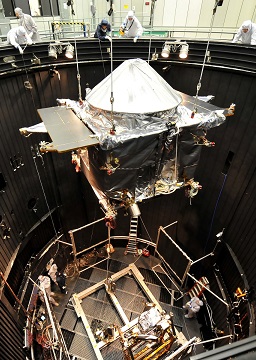Maven makes Mars-bound leap from Earth
 NASA has sent its most recent robotic explorer into space, launching the Maven spacecraft towards Mars.
NASA has sent its most recent robotic explorer into space, launching the Maven spacecraft towards Mars.
Maven is on a mission to unravel the ancient mystery of the red planet's radical climate change, which has seen it transform from warm and wet during its first billion years, to cold and dry today.
Maven has a long trip ahead of it, travelling more than 700 million kilometres to our neighbour’s orbit.
NASA researchers know that the early Martian atmosphere was dense enough to hold water and possibly support microbial life; they now want to know why so much of that atmosphere has been lost to space.
“We're just excited right now and hoping for the best,” said the University of Colorado’s Bruce Jakosky, principal scientist for Maven.
Maven will spend an entire Earth year measuring atmospheric gases once it reaches Mars on September 22, 2014.
The $AU716 million mission is NASA's 21st foray to the red planet since the 1960s, but the first dedicated to studying the upper Martian atmosphere.
Maven - short for Mars Atmosphere and Volatile Evolution, with an awkward capital ‘N’ in EvolutioN - carries eight scientific tools for sampling and testing elements of the atmosphere. The robot weighs 2,450 kilograms and from solar wingtip to wingtip, it stretches 11.4 metres.
Fourteen of NASA's 20 missions to Mars have succeeded - a much better strike rate than Russia. The list of nation’s shooting for Mars has expanded this year though, with India announcing its ‘Mangalyaan’ craft was heading up as well.
Maven should beat Mangalyaan by about two days – the race is on due to Earth and Mars’ habit of only lining up properly for a flight every two years.
Maven's instruments will be fired-up in the next few weeks, including an ultraviolet spectrograph to observe Comet ISON, which is now becoming visible from Earth as it streaks toward the sun.









 Print
Print